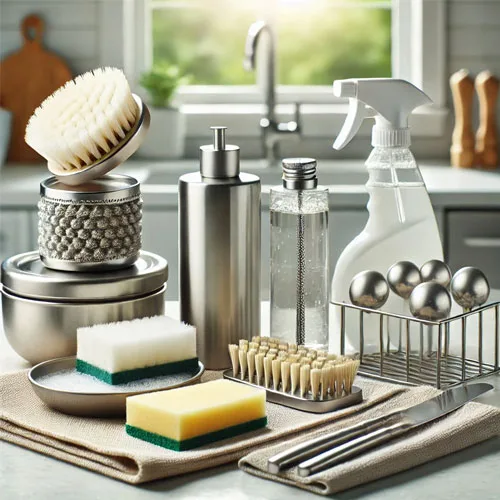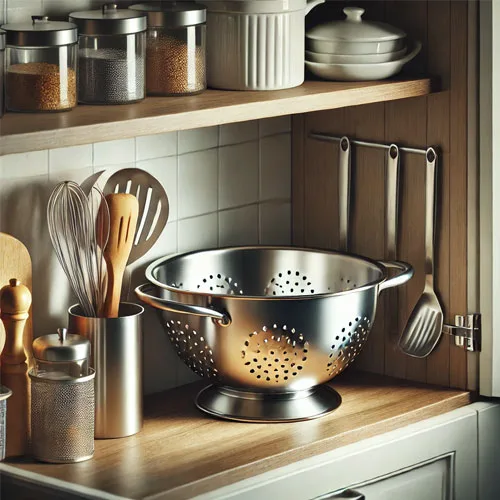Stainless steel kitchen items, no matter how big or small, add a touch of elegance to modern kitchens because of their sleek and shiny appearance. They are a popular choice, both for homes and businesses, because of their durability, functionality, resistance to rust, and reliability when it comes to meal preparation. And just like any other item in our household, these stainless steel kitchen items also deserve to be properly cared for in order to maintain their excellent condition and functionality over time. This article is a comprehensive guide on how to keep your stainless steel kitchen items looking brand new.
Regular Cleaning

Why clean regularly?
Regular cleaning ensures that the stainless steel’s hygienic and food safe conditions are maintained. This may be the simplest, yet remains to be the most effective way to prevent buildup of food residues and stains.
Best Practices
Make it a habit to wash your stainless steels with mild soap and warm water immediately after every use. This simple routine helps prevent grease buildup that may cause staining in the long run. Refrain from using harsh chemicals and abrasive scrubbing pads or steel wool as these materials can scratch the surface of your stainless steel kitchen items and eventually cause damage. Instead, opt for soft cloth and natural cleaning agents like baking soda and vinegar.
Use the Right Cleaning Tools

Tools for Effective Cleaning
As mentioned in the first tip, it is advisable to use soft cloths or non-abrasive sponges when cleaning your prized stainless steel kitchen items. Aside from soft cloths, investing in a high-quality microfiber towel or glass cloth is an effective way to remove smudges from stainless steels without scratching the surface. These materials are also good for polishing, making your kitchen items sparkly as ever.
Avoiding Damage
Scratches from steel wool and abrasive pads are irreversible, that’s why it is important to avoid using them when cleaning your stainless steel kitchen items at all cost.
Dry Thoroughly
Importance of drying
We always want to maintain the shiny appearance of our stainless steel kitchen items. Hence, drying them immediately after washing will help prevent water spots that can mar the appearance of our beloved utensils.
How to Dry
After rinsing, simply shake off excess water. Then, using a soft, lint-free towel, thoroughly dry each item and eliminate any lingering moisture. Pay particular attention to areas where water can accumulate, such as joints and crevices.
Polish for Shine
Why Polish?
Polishing after drying the stainless steels is a step that is often forgotten by most users. However, polishing is crucial as it improves the material’s surface quality and resistance to corrosion. If you want your stainless steel kitchen items to keep looking lustrous, then polishing is the way to go.
How to Polish
Did you know that a mixture of baking soda and water can make your stainless steels look as shiny as you first bought them? Yes, these kitchen staples, along with white vinegar and food safe mineral oil can be used to polish your kitchen utensils and gadgets. Simply dampen a soft, clean cloth with any of these mixtures and wipe down your utensils. Wipe again using a dry cloth to enhance the shine.
Avoid Chlorine and Abrasives
Why Avoid Certain Substances?
Chlorine is known to be a very powerful oxidizer which can cause the corrosion of chloride in stainless steels. Exposure to chlorine can also cause stainless steel discoloration. Conversely, abrasives have the potential to scratch and dull the surface of stainless steels.
Safe Alternatives
Keep your stainless steel kitchen items from being damaged by using mild cleaning agents and soft cloths.
Remove Stains Promptly
Common Stains
The most common stains are water spots, food residues, and fingerprints. In some instances, the stain or discoloring of stainless steels is a reaction to minerals in water, certain types of dishwasher detergent or starchy ingredients.
How to Remove Stains
For acidic stains, simply use a mix white vinegar and water; lemon juice can be used as an alternative. While for tougher stains, baking soda paste works wonders. Baking soda is a kitchen staple that offers many uses – one of which is to remove stubborn stains or discoloration from stainless steel kitchen utensils and gadgets. The process is very simple. Form a paste by mixing baking soda and a small amount of water, apply it on the stained area, and let it soak for a few minutes. Afterwards, gently scrub with a soft sponge, rinse thoroughly and dry immediately.
Store Properly

Proper Storage Tips
Scratching, denting, oxidation, loosened handles – all these can be prevented if stainless steel kitchen items are stored properly. For starters, make sure your utensils and cookware are completely clean and dry before storing. Any lingering moisture or food residue can lead to rust or discoloration. You may consider hanging your stainless steel pans and cookware pots to allow better air circulation. This option works for frequently used kitchen items.
Preventing Damage
It is good to utilize utensil holders or organizers when storing your stainless steel kitchen items. Alternatively, if stacking cannot be avoided, use separators or soft linens to prevent scratches and dents. Ultimately, the rule of thumb is to store your stainless steels in a cool, dry place to prevent damage caused by moisture.
Address Rust and Discoloration
Identifying Rust and Discoloration
Two of the most common causes of rust and discoloration in stainless steel kitchen items are chlorides and acids. These chemicals can cause a rainbow-looking stain on the surface of stainless steels. While it is completely safe and does not have any effect on food, it sure can be very bothersome.
Treatment Methods
It’s normal to worry whenever you see a sign of discoloration, but don’t fret, the solution is very simple. A simple solution of vinegar and water can address this issue. Mix half vinegar and half water, and using a non-abrasive sponge, gently scrub the affected part. Afterwards, just rinse and dry. Apply the steps mentioned above on how to dry your stainless steels.
Inspect Regularly
Why Regular Inspections Matter
Make it a habit to regularly inspect your stainless steel kitchen items for any signs of damage. This way, any minor issues can be addressed before they become major problems.
What to Check For
Look for any cracks, bends, or loose parts, and replace or repair them as necessary.
Follow Manufacturer’s Instructions

Importance of Following Instructions
Each stainless steel is different from the other. Following the manufacturer’s instructions ensures proper care of our kitchen items and avoids voiding warranties.
Where to Find Instructions
You can easily find these instructions in the packaging, user manual or manufacturer’s website.
Bonus Tip: Prevention is Key
Just like how the old saying goes, “Prevention is better than cure.” For stainless steel cookware, it is important to keep these few things in mind to prevent any damage to your prized kitchenware:
• Always preheat your stainless steel cookware before cooking to avoid food from sticking.
• Do not overheat. Stainless steel cookware only require low to medium heat for ideal cooking. Extended exposure to high temperature may cause the bottom of your cookware to warp and become uneven.
• Use utensils made from wood or silicone as they won’t scratch the bottom of your cookware.
Proper care of your stainless steel kitchen utensils and gadgets is essential to ensure their longevity and maintain their aesthetic appeal. By incorporating these ten best practices into your routine, you can keep your utensils in top condition. Regular cleaning, gentle handling, and proper storage are key to preserving the quality and beauty of stainless steel, making it a worthwhile investment for any kitchen.
By following these tips, you’ll not only extend the life of your utensils but also keep them looking as good as new. So, give your stainless steel kitchen tools the care they deserve and enjoy the benefits of their durability and elegance in your cooking adventures!